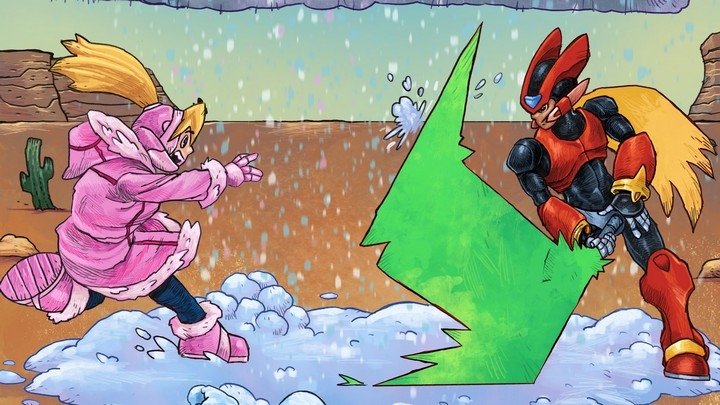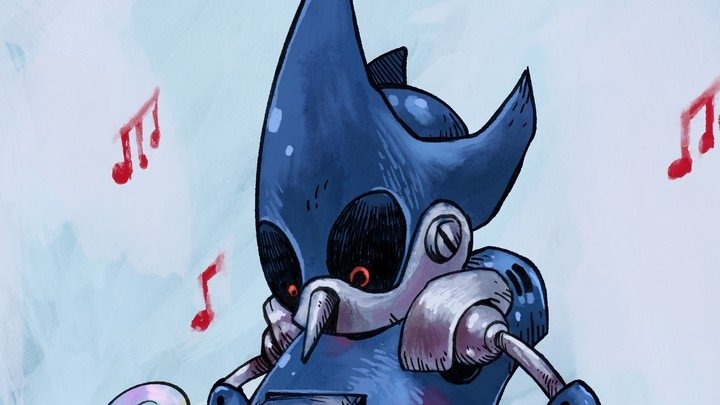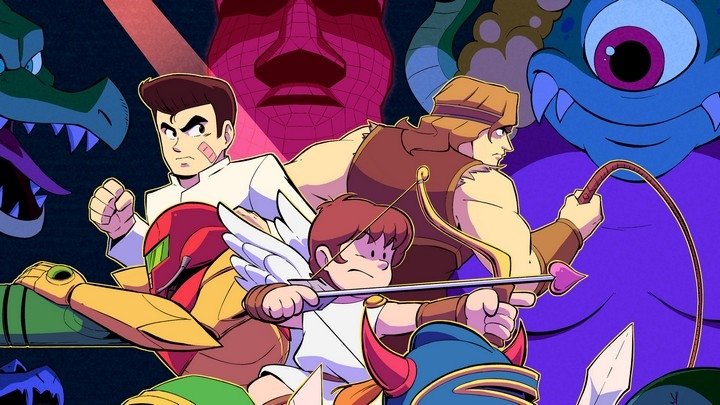Samus returns, but Metroid still seems a little lost
Despite including numerous improvements, Nintendo's new Metroid II remake doesn't quite rank with the series' best.
I've had a brand new Metroid game in my hands for a couple of weeks now (technically, a new version of an old Metroid game, but it's new in every way that actually matters) and somehow, I haven't finished it. I keep trying to imagine how I'd explain this to a younger version of myself: That they finally created that Metroid II remake we all began demanding the moment the credits rolled on Zero Mission, yet I didn't extract every last ounce of content from it immediately. It inspires a sort of muted disappointment in myself. But the fact of the matter is, I haven't finished Metroid: Samus Returns, and the prospect of doing so hangs like a dead weight over me. Metroid should be compulsion for me; Samus Returns feels like an obligation.
Sorry, that sounds more dire than the game deserves. Samus Returns isn't bad at all — on the contrary, it's quite excellent in most respects. It gives a flawed handheld game from 25 years ago the comprehensive overhaul it so desperately needed, and by and large it does a fine job of it. My issues with Samus Returns reflect my own expectations from a Metroid game and my personal feelings about the design philosophy that drives the series. Most people likely don't have my hang-ups and will probably enjoy Samus Returns a lot more than I have.
There's a lot to like about it. Developer MercurySteam has done a great deal to restore protagonist Samus Aran to the state of being the powerful, efficient hunter everyone saw her as before Metroid: Other M's misbegotten cutscenes turned her into a sullen child with a desperate need for parental validation. She glides silently through the underground passages of planet SR-388 in search of parasitic metroids to destroy, dispatching foes with a combination of gunplay and brute force. She descends ever further into the subterranean depths, far beyond the point an advanced Galactic Federation task force managed to reach (their corpses litter the opening area, but they disappear as you advance into deeper zones of the planet). The remake's title has a layered meaning: Samus Returns inverts Metroid II's subtitle, Return of Samus, but it also speaks to the fact that this is the Samus Aran fans have enshrined in their minds rather than the meek, submissive brat of Other M.

So, too, have the metroids themselves been powered-up. The original Metroid II centered its mission around the eradication of the species, but overall the creatures felt rather underwhelming. The only real danger they posed was one of attrition: Because Samus's forays into the tunnels of SR-388 often took her far from save stations and energy recharge ports, a series of multiple consecutive battles with evolved metroids could threaten to drain the player's resources. Individually, though, the metroids never felt terribly dangerous, even the missile-sponge omegas. That's not the case here. Every metroid form possesses its own distinct forms of attack and defense, and even within those different evolutions you'll encounter a range of different behaviors and powers.
Each and every one of your dozens of metroid battles constitutes, effectively, a boss battle, capable of depleting Samus's health in short order. The developeds have deemed them to be sufficiently difficult that you're given an automatic, temporary checkpoint before each one in the event you don't survive your first attempt. And in fact, you absolutely will not survive every single metroid encounter, even if you can blast through the ones in Metroid II without flinching. They're tough, and aggressive.
Likewise, the world of SR-388 has undergone a radical overhaul as well. Things that the monochrome Game Boy visuals only hinted at, like the fact that much of the SR-388 underground appeared to consist largely of natural tunnels branching away from ancient ruins, make the leap from subtext to text. Now these crumbling ancient structures, long abandoned by the chozo race, both house Samus's powers and serve as hubs for each new push into the underworld, with structures vanishing into the distance in the backgrounds. They also add a little bit of narrative clarity to the game's structure: You need to destroy set quotas of metroids in order to delve further into the world not because the monsters' deaths somehow cause earthquakes, but because the chozo have established barriers that require Samus to claim a bounty of sorts on eradicated parasites. That doesn't really make any sense, either, but at least it suggests someone was trying.

In its basic outline, the new labyrinth greatly resembles the shape of the one in Metroid II. Objects, power-ups, enemies, and bosses generally appear in the same relative locations as in the original game — you can use a map of the Game Boy game to get a pretty good sense of where your targets are. Now, actually reaching those goals — that's something else. Samus Returns adds an enormous amount of texture and density to SR-388, taking the barebones layout of the 8-bit world and building more complex structure (akin to Fusion's or Zero Mission's) into that framework.
All of these changes should add up to a pitch-perfect remake, a comprehensive and much-needed overhaul for a game that, while impressive for its time and platform, feels like a clumsy outlier among its kin. Yet I can't say that's entirely true: In some ways, Samus Returns feels like less than the sum of its parts.
My frustration with the game genuinely does stem from the cumulative effects of all its new elements combined. Individually, they're fantastic. Combined, they frequently turn the game into a slog. After my first couple of happy hours with the game, playing Samus Returns has increasingly come to feel like a chore.
If I were to point at any single element of Samus Returns that bears the blame for my weariness, it would be the new melee counter system. While much of the action involves running and gunning per usual for Metroid — and I love the fact that holding the L shoulder button now causes Samus to stand in place so she can freely aim at enemies through 360º, a la Gunstar Blue — the series' standard gunplay has been replaced as the central combat mechanic by a short-range counter-attack. Most enemies (including bosses) have a special charging offensive action that hits Samus for enormous damage if it connects; the idea is that when a foe charges, you need to counter with a melee strike to defend Samus and stun the enemy. A melee counter followed immediately by an attack will destroy all but a handful of foes in a single shot. In the case of bosses, melee counter-strikes instead initiate cinematic attack sequences that won't finish the battle but definitely soften up an opponent.

The boss melee events remind me a great deal of the boss-battle quick-time events in the last MercurySteam game I played, Castlevania: Mirror of Fate. There's no question that Samus Returns turned out a lot better than the dreary mess that Konami delivered with Mirror of Fate, but both games share a common obsession with constant moment-to-moment combat that gums the gears of their pacing.
In this case, the emphasis on Samus's melee counters forces the action to take a stuttering, stop-start flow. Enemies hit hard, and they can soak up a ton of damage (even once you collect more powerful arm cannon beams). Melee counters become the most effective way to fight, since they allow you to take out practically any standard enemy with a single shot. But this means that every step of the way, you're constantly stopping to wait for a monster to launch into a charging attack; because melee counters are a defensive — and therefore passive — ability, the action in Samus Returns largely requires enemies to take the initiative, rather than Samus.
My problem is that combat has never really felt like the point of Metroid to me. Fighting and shooting are a part of the action, to be sure; but at their best, Metroid games use conflict to create puzzles or obstacles to exploration. You enter a new room, take stock of the hazards before you, and clear them out before moving along to explore. But later, when you backtrack over that old ground, the monsters that once presented a challenge should amount to little more than scenery. Here, though, the wildlife of SR-388 takes a lot longer to become inconsequential thanks to those vicious rushing attacks. (The close-in camera view, which makes it difficult to see many monsters until you've come into their striking range, doesn't help.) You have to take a more deliberate approach to backtracking than in previous 2D Metroid games.

And there's far more backtracking here than in older games. Metroid II had an enormous, sprawling world, and that hasn't changed in the remake. But MercurySteam has divided it up with all sorts of barriers than didn't exist before: Doors that require wave beams, or special Aion upgrade attacks, or various other attributes. This more granular approach to design sounds good at first, but after a while it starts to become monotonous — a failing of Metroid II that MercurySteam surely intended to rectify by boosting SR-388's complexity. At times, though, it feels like all they've done is shuffle around the tedium. The denser world, zoomed-in viewpoint, and high emphasis on melee counters make for a frustrating combination.
Samus's combat design suffers from other annoying quirks as well. The ice beam halves Samus's attack power, similar to the way it did in the original NES Metroid. There, though, the reduction in attack power resulted from the fact that alternating shots would freeze and unfreeze foes. That isn't the case here; ice beams simply inflict less damage than other weapons, rendering them largely useless in combat when you don't specifically need to freeze foes.
Samus's new Aion abilities also need a little more fine-tuning. They allow Samus to use advanced abilities — such as increasing her damage output, revealing secrets on the in-game map, or soaking up damage — but they run off their own special energy meter that requires Samus to collect an addition form of energy drop (besides health and weapon refills) from defeated foes. This is fine until you acquire the burst fire Aion that's required to defeat certain enemies and open specific doors; burst fire drains the Aion meter quickly, and you soon find yourself grinding for Aion energy. Incidentally, enemies drop extra Aion juice when you defeat them with a melee counter, creating yet another reason to engage in the stop-start rhythm of counter-driven combat.

Minor details like ice beam and Aion depletion serve to bog down the flow of Samus Returns. The game becomes a lot more about granular combat than any other Metroid game outside of Other M, but it lacks the dynamic mechanics of that game (the one thing Team Ninja unquestionably got right in their collaboration with Nintendo). But it all gets in the way of the joy of exploration. The most interesting conflict in Metroid for me has never been Samus versus space monsters but rather me versus the labyrinth. And there's certainly plenty of the latter here, but the labyrinth's design feels drawn out, and it's difficult to move around from place to place efficiently when you have to pause to wait for every monster along the way to take a swipe at you every time you pass through their hunting grounds.
I hate to sound too down on the game. As I said before, there's a lot to like about it. It looks great, controls well, and the main battles against the metroids have real bite. I fully intend to keep plugging away at it a bit at a time — I'll get through it pretty soon. While it's far from a perfect return to form for the series, Samus Returns definitely feels like a step back in the right direction after a seven-year hiatus. I just don't think the constant focus on combat is quite what I'm looking for in a Metroid game. But maybe that's OK; the metroidvania genre has become crowded with countless other games that do the Metroid thing note-perfectly, and I can't blame Nintendo for wanting to differentiate their work from its imitators. And maybe the game's methodical pace and counter-strike conflict are precisely what a new generation of fans weaned on Dark Souls wants from Metroid. Samus and I have had 30 years of great adventures together; it's OK for us to have grown apart after all this time.




